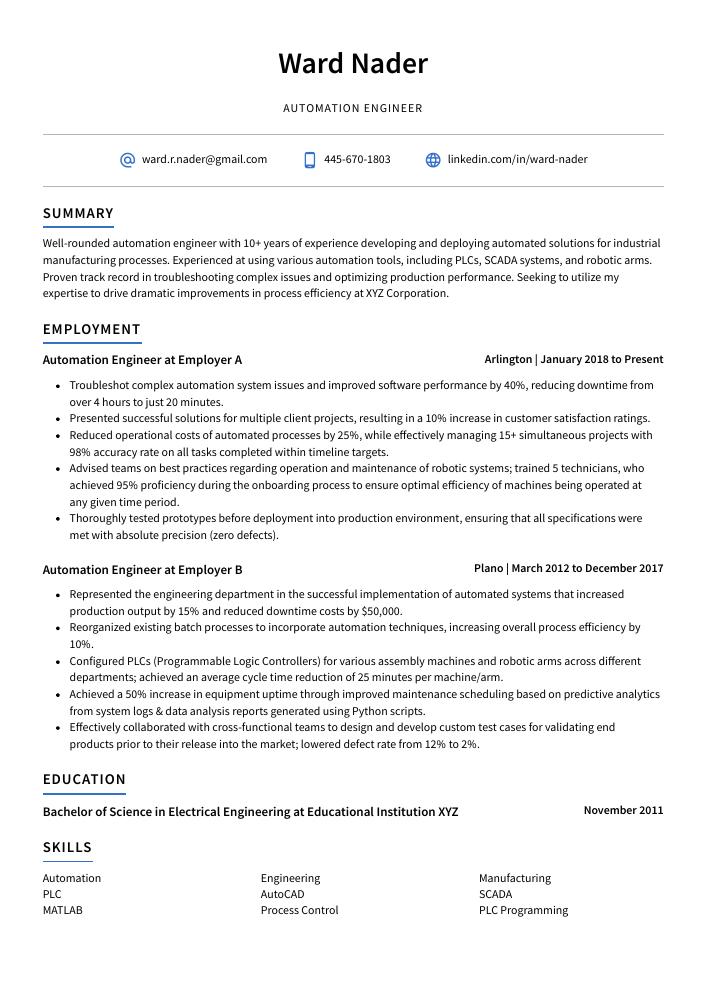Automation Engineer Resume Guide
Automation Engineers are responsible for designing and implementing automated systems to improve productivity, accuracy and safety. They develop robotics, computer-integrated manufacturing systems and other advanced automation solutions in order to optimize production processes. Additionally, they analyze data on the performance of existing systems in order to identify areas that need improvement or further development.
Your knack for automation engineering is unmatched, and any company that needs it would be lucky to have you. But before they can even consider you as a candidate, they need to know who you are. To make your name known, write an attention-grabbing resume.
This guide will walk you through the entire process of creating a top-notch resume. We first show you a complete example and then break down what each resume section should look like.
Table of Contents
The guide is divided into sections for your convenience. You can read it from beginning to end or use the table of contents below to jump to a specific part.
Automation Engineer Resume Sample
Ward Nader
Automation Engineer
ward.r.nader@gmail.com
445-670-1803
linkedin.com/in/ward-nader
Summary
Well-rounded automation engineer with 10+ years of experience developing and deploying automated solutions for industrial manufacturing processes. Experienced at using various automation tools, including PLCs, SCADA systems, and robotic arms. Proven track record in troubleshooting complex issues and optimizing production performance. Seeking to utilize my expertise to drive dramatic improvements in process efficiency at XYZ Corporation.
Experience
Automation Engineer, Employer A
Arlington, Jan 2018 – Present
- Troubleshot complex automation system issues and improved software performance by 40%, reducing downtime from over 4 hours to just 20 minutes.
- Presented successful solutions for multiple client projects, resulting in a 10% increase in customer satisfaction ratings.
- Reduced operational costs of automated processes by 25%, while effectively managing 15+ simultaneous projects with 98% accuracy rate on all tasks completed within timeline targets.
- Advised teams on best practices regarding operation and maintenance of robotic systems; trained 5 technicians, who achieved 95% proficiency during the onboarding process to ensure optimal efficiency of machines being operated at any given time period.
- Thoroughly tested prototypes before deployment into production environment, ensuring that all specifications were met with absolute precision (zero defects).
Automation Engineer, Employer B
Plano, Mar 2012 – Dec 2017
- Represented the engineering department in the successful implementation of automated systems that increased production output by 15% and reduced downtime costs by $50,000.
- Reorganized existing batch processes to incorporate automation techniques, increasing overall process efficiency by 10%.
- Configured PLCs (Programmable Logic Controllers) for various assembly machines and robotic arms across different departments; achieved an average cycle time reduction of 25 minutes per machine/arm.
- Achieved a 50% increase in equipment uptime through improved maintenance scheduling based on predictive analytics from system logs & data analysis reports generated using Python scripts.
- Effectively collaborated with cross-functional teams to design and develop custom test cases for validating end products prior to their release into the market; lowered defect rate from 12% to 2%.
Skills
- Automation
- Engineering
- Manufacturing
- PLC
- AutoCAD
- SCADA
- MATLAB
- Process Control
- PLC Programming
Education
Bachelor of Science in Electrical Engineering
Educational Institution XYZ
Nov 2011
Certifications
Certified Automation Professional (CAP)
International Society of Automation
May 2017
1. Summary / Objective
A resume summary for an automation engineer should be written to capture the attention of a potential employer. Include your most impressive qualifications, such as experience with programming languages and frameworks, certifications in robotics or automation engineering, and successful projects you have completed. You can also mention any awards or recognition you have received for your work in this field.
Below are some resume summary examples:
Driven automation engineer with experience in designing, developing, and implementing automated solutions. Skilled at developing cost-effective automation systems that improve production quality while reducing costs. At XYZ Corporation, created a multi-platform industrial control system to automate processes across multiple sites; increased efficiency by 30%. Recognized for consistently delivering projects on time and under budget.
Talented automation engineer with 10+ years of experience in designing and developing automation systems. Skilled at creating user-friendly interfaces, troubleshooting, testing and validating automated solutions to streamline daily operations. Proven track record of success in deploying multiple projects across the globe on time while meeting expectations. Highly proficient with programming languages such as Python, Java and C++.
Skilled automation engineer with 5+ years of experience developing and deploying automated testing solutions. Proven record in verifying software performance, scalability, reliability and security using a variety of tools such as Robot Framework, Selenium WebDriver, Jenkins CI/CD pipelines. Adept at troubleshooting errors to minimize downtime for clients. Seeking an opportunity to leverage my skills at ABC Corporation.
Committed automation engineer with 5+ years of experience developing and delivering automation solutions. Proven track record in designing, testing and implementing software systems to optimize workflows for clients across the globe. Skilled at programming using Java, Python, JavaScript, HTML/CSS and SQL. Seeking a role at ABC Tech to lead the development of innovative automated solutions that drive business success.
Seasoned automation engineer with 8+ years of experience developing and deploying cutting-edge automation solutions. Proven ability to increase efficiency, reduce errors, and improve accuracy across various industries. Skilled in scripting languages such as Python and Bash for creating automated processes. Seeking a role at ABC Tech where I can utilize my expertise to help build reliable automation systems.
Proficient Automation Engineer with 7+ years of experience developing and deploying automated solutions to streamline processes. Proven track record in designing, coding, testing and debugging systems; able to manage complex projects while meeting tight deadlines. Seeking an opportunity at ABC Corp to apply my automation skills towards optimizing operations and improving business performance.
Determined automation engineer with 5+ years of experience developing test automation solutions for software applications. Seeking to join ABC Tech and apply expertise in scripting languages and tools, such as Selenium WebDriver, Cucumber, Java, Python and Jenkins. In previous roles designed automated tests that improved product quality by 40% while reducing testing time by 30%.
Detail-oriented automation engineer with 5+ years of experience developing, testing, and deploying automated solutions for large-scale distributed systems. Proficient in a variety of programming languages and frameworks (NodeJS, Python). Seeking to join ABC Tech as an automation engineer to build reliable and efficient software that will help the organization reach its goals.
2. Experience / Employment
In the experience section, you want to provide details about your employment history. It should be written in reverse chronological order, meaning the most recent position is listed first.
When writing this section, stick to bullet points as much as possible; doing so makes it easier for the reader to take in what you have provided quickly and efficiently. When talking about what you did at each job role, make sure that these are detailed and include quantifiable results where applicable.
For example, instead of saying “Developed automation processes,” you could say “Created automated scripts using Python which reduced manual testing time by 30%, allowing more efficient use of resources.”
To write effective bullet points, begin with a strong verb or adverb. Industry specific verbs to use are:
- Automated
- Programmed
- Configured
- Monitored
- Optimized
- Developed
- Implemented
- Tested
- Debugged
- Troubleshot
- Analyzed
- Designed
- Integrated
- Upgraded
- Documented
Other general verbs you can use are:
- Achieved
- Advised
- Assessed
- Compiled
- Coordinated
- Demonstrated
- Expedited
- Facilitated
- Formulated
- Improved
- Introduced
- Mentored
- Participated
- Prepared
- Presented
- Reduced
- Reorganized
- Represented
- Revised
- Spearheaded
- Streamlined
- Structured
- Utilized
Below are some example bullet points:
- Meticulously designed and implemented automated processes for 10+ manufacturing systems, resulting in a 25% decrease in production time.
- Documented process automation designs, test results and other engineering activities; created technical documentation to support maintenance efforts of the automation systems.
- Automated 60+ manual testing procedures using scripting language and reduced overall system testing costs by $5k per cycle.
- Assessed existing control architectures on 15+ machines, identified areas of improvement and upgraded outdated components with modern technology to increase machine efficiency by 35%.
- Streamlined deployment strategies for newly developed software applications across 200 sites worldwide within 6 months; improved customer service response times by 20%.
- Coordinated the development of automation systems for four major engineering projects, resulting in a 20% improvement in production efficiency and an $11,000 reduction in operating costs.
- Demonstrated technical proficiency when installing PLCs (Programmable Logic Controllers), servo drives and other equipment used to automate industrial processes; successfully completed 3 projects ahead of schedule with no errors or complications.
- Substantially improved the performance of 8 existing automated manufacturing lines by writing software code that increased the speed at which machines ran by 30%.
- Expedited system maintenance procedures while managing repair activities on 12 different robotics platforms; reduced downtime from 24 hours to 6 hours per incident on average within 3 months period as Lead Technician Engineer.
- Debugged hardware & software issues related to automated controls on 16 pieces of machinery over a 2 year period, helping increase operational uptime by 10%.
- Proficiently designed automation systems to improve overall production efficiency by 25%; reduced manual labor costs by 10%.
- Improved existing control logic and simplified wiring diagrams for 5+ automated machine lines, resulting in enhanced process reliability with minimal downtime.
- Integrated advanced technologies such as AI-based vision systems, motion controllers and temperature regulators into the factory network; upgraded software programs on 8 machines to achieve greater accuracy of parts assembly operations within a shorter time frame.
- Upgraded robotic arms’ firmware programming and implemented safety protocols to safeguard workers from hazardous work environments; developed new algorithms that increased robot speeds by 30% without compromising quality standards at any stage of the manufacturing cycle.
- Spearheaded an initiative that cut set up times in half while still ensuring high levels of precision during product testing phases; improved overall throughput rate across all departments by 15%.
- Monitored and maintained automation process and system performance, troubleshooting any issues to ensure seamless operation of production line; increased efficiency by 10% in the first quarter.
- Designed automated control systems using computer-aided design (CAD) software such as AutoCAD and SolidWorks; developed 5 new robotic manufacturing processes within a year.
- Tested all automation equipment for functionality before implementation on the production floor; reduced potential downtime incidents by 45%.
- Actively collaborated with cross-functional teams including mechanical engineers, electrical engineers, software developers and technicians when building prototypes or introducing changes in existing machinery configurations/setups.
- Implemented high levels of safety standards while operating automated machines in order to avoid accidents or injury; decreased machine breakdowns due to improper use by 30%.
- Accurately designed and implemented automation scripts for 10+ software systems, resulting in a 40% reduction of manual labor.
- Participated in the development of 3 new automated solutions to improve productivity across various departments; reduced debugging time by 25%.
- Developed and maintained user-friendly interfaces for all automation programs, ensuring that end users were able to navigate with ease; increased system usability by 15%.
- Prepared detailed technical documents outlining automation processes as well as troubleshooting guidelines; improved team efficiency by 20 hours per month on average.
- Facilitated regular training sessions on best practices regarding script writing and debugging techniques, enabling colleagues to stay up to date with industry trends & standards at all times.
- Structured, installed, and programmed 10+ automated control systems to increase production efficiency by 25%.
- Mentored a team of 6 junior automation engineers on the proper design & installation techniques for robotic and industrial equipment.
- Diligently maintained over 50 automated machines daily to meet client deadlines without any major faults or breakdowns in service; resulting in 95% customer satisfaction rate with minimal complaints about machine performance/reliability.
- Utilized PLC programming languages such as Ladder Logic (LL), Structured Text (ST) & Function Block Diagrams (FBD) to create data-driven algorithms that optimized labor costs by 40%.
- Programmed custom applications using C++, Python & Visual Basic scripting languages for process automation tasks like material handling and quality assurance checks; saved an average of 8 hours per week on manual labor requirements due to successful implementation of these scripts.
- Reliably automated processes and systems for over 30 clients, resulting in a reduction of manual labor costs by 15% within the first year.
- Compiled detailed technical documentation on automation system design changes, which saved 300+ hours of engineering time annually.
- Introduced an advanced fault-tolerance mechanism to the automation framework that reduced downtime incidents by 50%.
- Revised existing troubleshooting protocols used for identifying system malfunctions; improved accuracy rate from 40% to 90%.
- Analyzed data sets collected from various machine learning experiments conducted as part of research projects; identified areas where algorithmic improvements would result in higher performance levels with up to 10% efficiency gain predicted overall.
3. Skills
Skill requirements will differ from one employer to the next; this can easily be ascertained from the job posting. Organization A may be looking for someone with experience in Python, while Organization B may be seeking a candidate who is proficient in Java.
It is essential to keep this in mind because of the applicant tracking systems utilized by many companies. Their role is to analyze resumes for certain characteristics (such as specific keywords), filtering out the ones they deem not to be a high-quality match for that particular job.
Once listed here, you can further elaborate on your skillset by discussing it in more detail in other areas, such as the summary or experience section.
Below is a list of common skills & terms:
- Agile Methodologies
- Allen Bradley
- AutoCAD
- Automation
- C
- C#
- C++
- Commissioning
- Continuous Improvement
- Control Logic
- Control Systems Design
- DCS
- Data Analysis
- Electrical Engineering
- Electricians
- Electronics
- Engineering
- HMI Programming
- HMIS
- HTML
- Instrumentation
- Integration
- Java
- JavaScript
- Lean Manufacturing
- Linux
- MATLAB
- Manufacturing
- Mechanical Engineering
- Microsoft SQL Server
- MySQL
- PLC
- PLC Programming
- Process Automation
- Process Control
- Process Engineering
- Process Improvement
- Product Development
- Programmable Logic Controller
- Programming
- Project Engineering
- Project Planning
- Python
- Quality Assurance
- Robotics
- Root Cause Analysis
- SCADA
- SOLIDWORKS
- SQL
- Six Sigma
- Software Development
- Team Leadership
- Teamwork
- Test Automation
- Testing
- Troubleshooting
- Unix
- Windows
- Wonderware
- XML
4. Education
Mentioning your education on your resume will depend on how much experience you have. If you are just starting out and don’t have a lot of relevant work experience, include an education section below your resume objective. However, if you already have several years of automation engineering under your belt, it might not be necessary to mention the educational background altogether.
If including an education section is appropriate for this role, try to highlight courses or subjects that pertain specifically to automation engineering jobs.
Bachelor of Science in Electrical Engineering
Educational Institution XYZ
Nov 2011
5. Certifications
Certifications are a great way to demonstrate your proficiency in a particular field. They are also an excellent indicator of how up-to-date you are with the latest industry trends and developments, as well as any professional development courses you may have taken.
If there is a certification that is relevant to the job role you are applying for, make sure it’s included on your resume so hiring managers can see what qualifications and experience you possess.
Certified Automation Professional (CAP)
International Society of Automation
May 2017
6. Contact Info
Your name should be the first thing a reader sees when viewing your resume, so ensure its positioning is prominent. Your phone number should be written in the most commonly used format in your country/city/state, and your email address should be professional.
You can also choose to include a link to your LinkedIn profile, personal website, or other online platforms relevant to your industry.
Finally, name your resume file appropriately to help hiring managers; for Ward Nader, this would be Ward-Nader-resume.pdf or Ward-Nader-resume.docx.
7. Cover Letter
Cover letters are a great way to make your job application stand out from the crowd. While most jobs won’t require you to submit one, it’s highly recommended that you do so – as this can help recruiters understand more about who you are and why they should consider hiring you for the role.
A cover letter is usually made up of 2-4 paragraphs which provide additional information not found on your resume. It allows you to explain why your experience makes you an ideal candidate and gives employers further insight into what kind of person they could potentially be working with.
Below is an example cover letter:
Dear Casandra,
I am writing to apply for the position of Automation Engineer at your company. With experience in designing and implementing automated testing solutions, I am confident I will make a positive impact on your team.
In my previous role as an Automation Engineer at [company name], I was responsible for developing and maintaining our test automation framework. This involved working with developers to understand new features and create tests accordingly. I also wrote custom scripts to automate repetitive tasks such as data entry and file validation. As a result of my efforts, we were able to achieve 90% test coverage across all projects.
I have a strong technical background, with a Bachelor’s degree in Computer Science and experience using various programming languages (such as Java, Python, and JavaScript) to develop software applications. My analytical skills enable me to quickly identify areas that can be improved through automation. In addition, I am an effective communicator who is able to explain complex technical concepts clearly to non-technical staff members.
I believe my skills and experience would be an asset to your company and look forward to discussing how I can contribute to your team’s success in the future.
Sincerely,
Ward
Automation Engineer Resume Templates
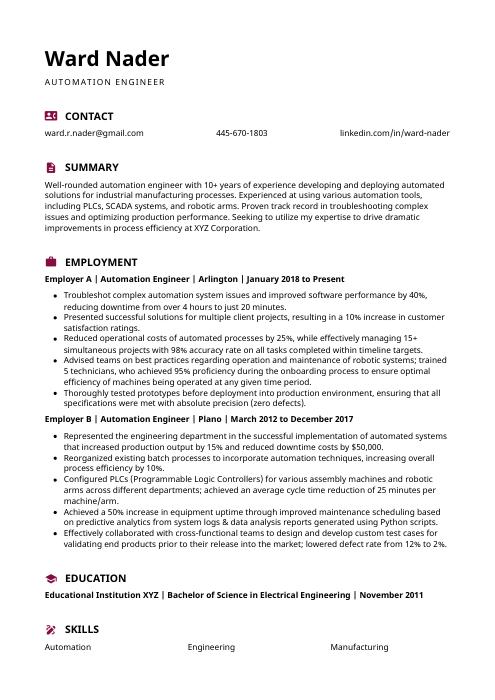 Hoopoe
Hoopoe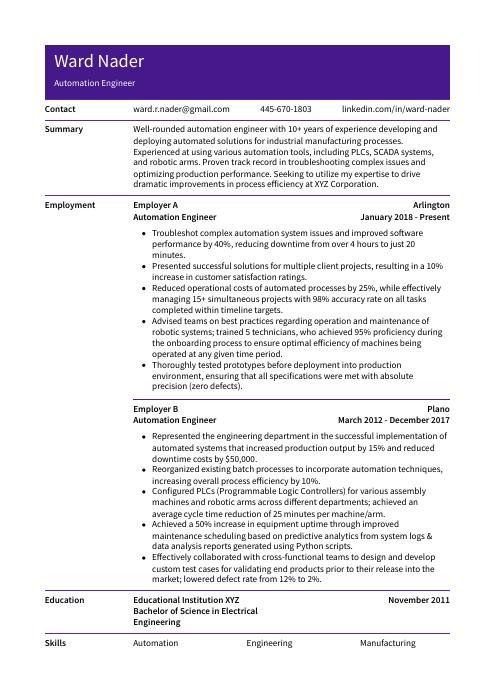 Pika
Pika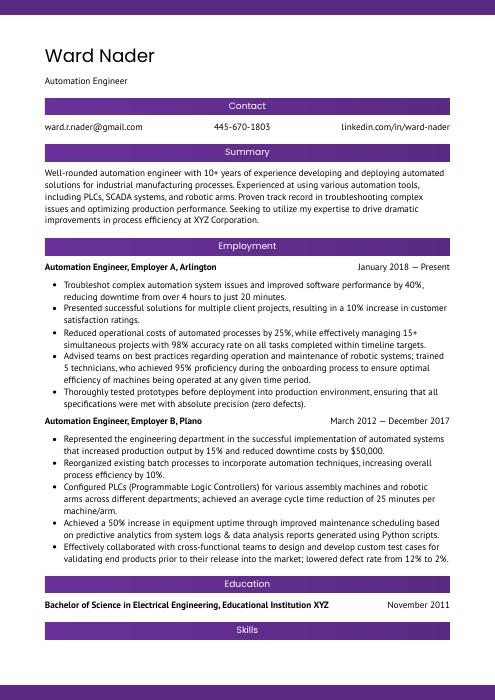 Jerboa
Jerboa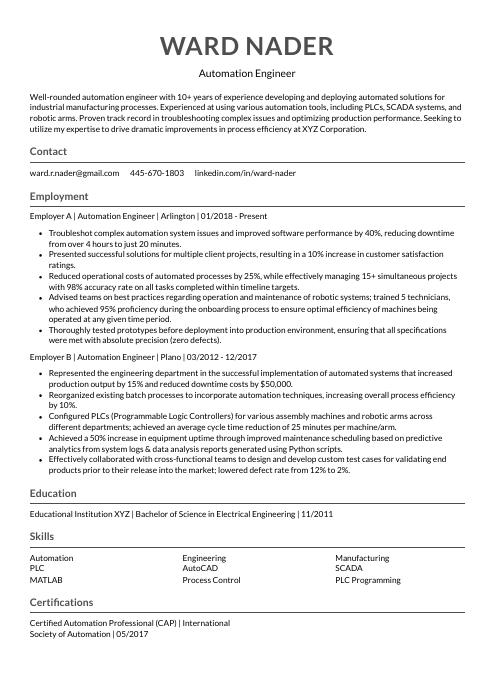 Indri
Indri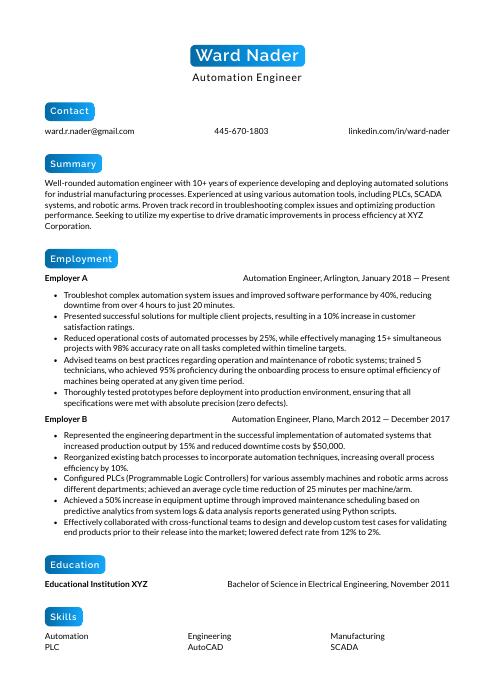 Kinkajou
Kinkajou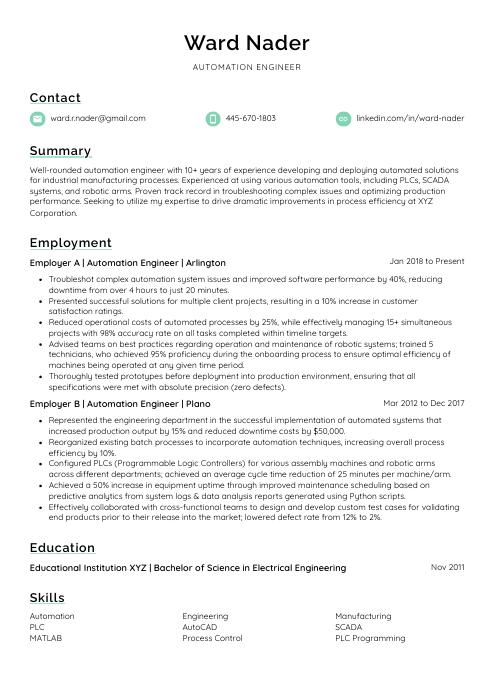 Lorikeet
Lorikeet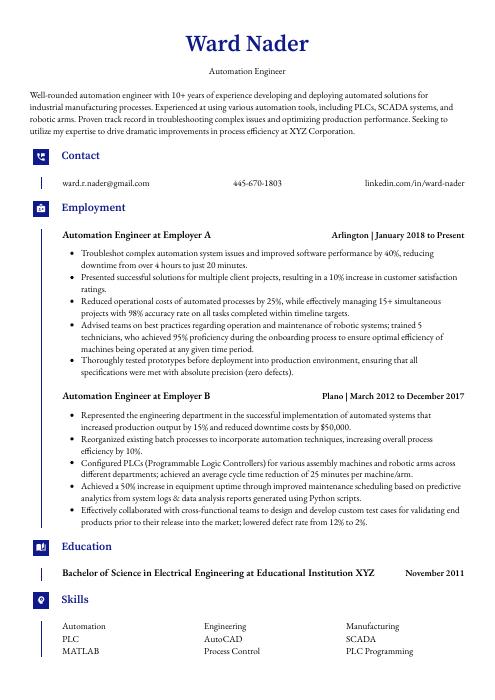 Gharial
Gharial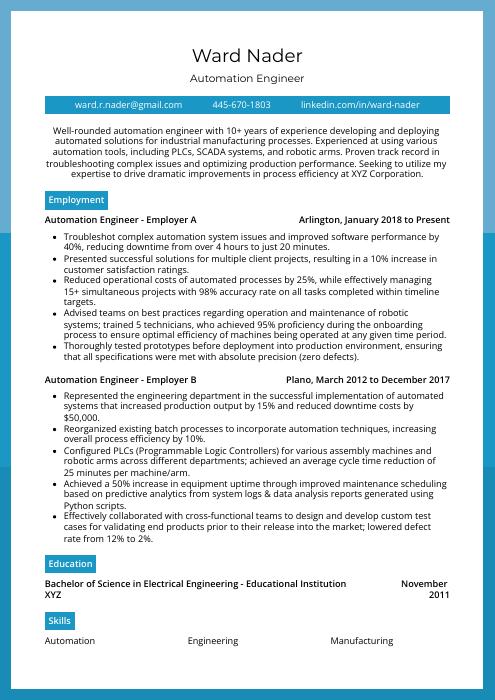 Rhea
Rhea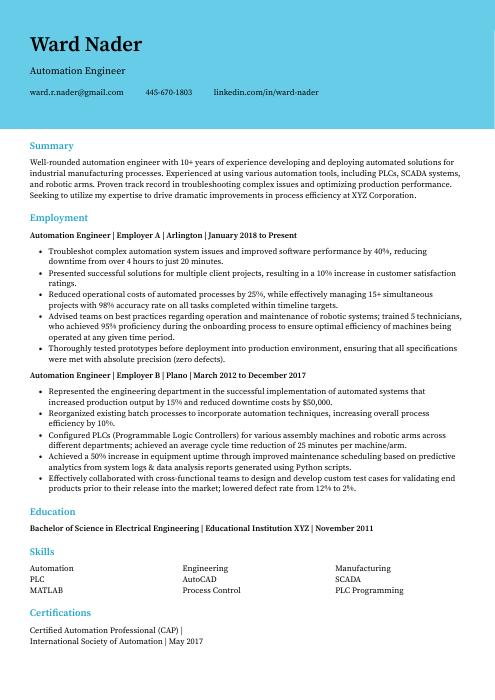 Dugong
Dugong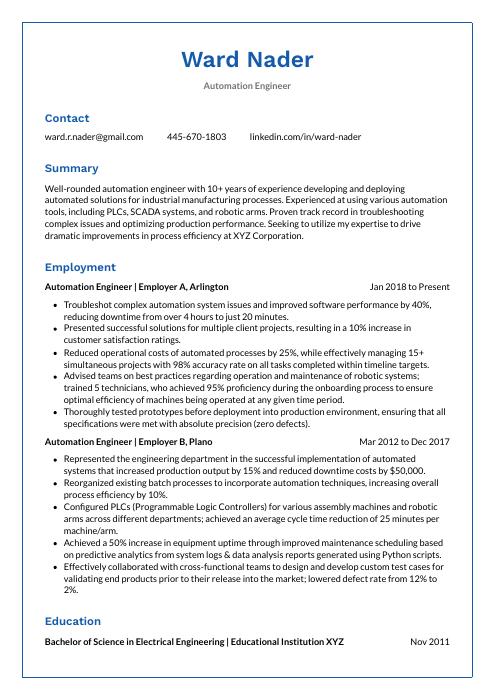 Markhor
Markhor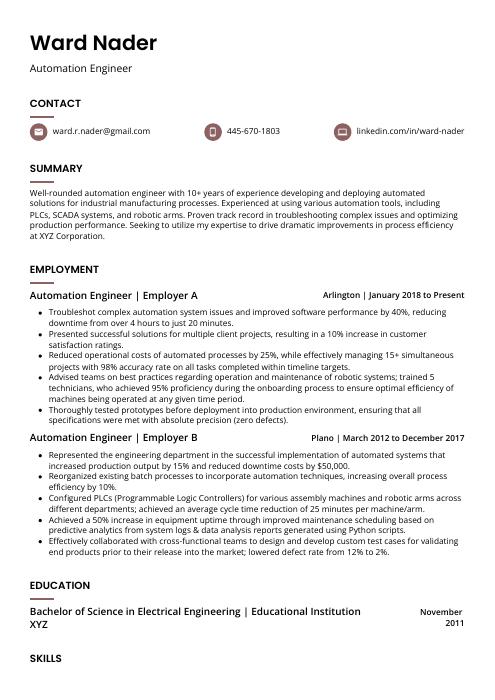 Fossa
Fossa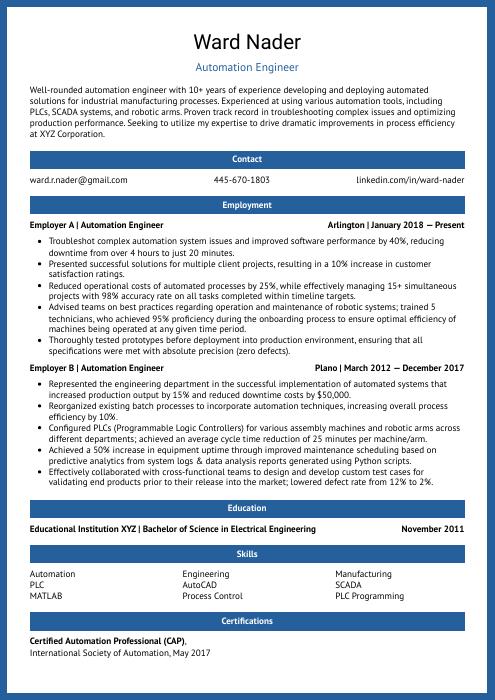 Ocelot
Ocelot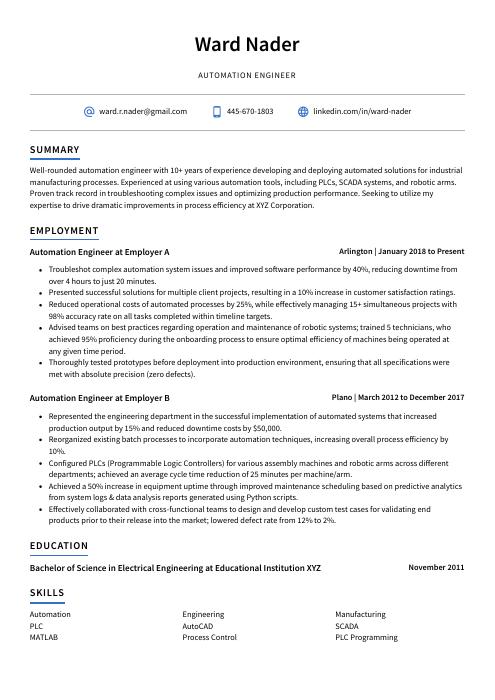 Axolotl
Axolotl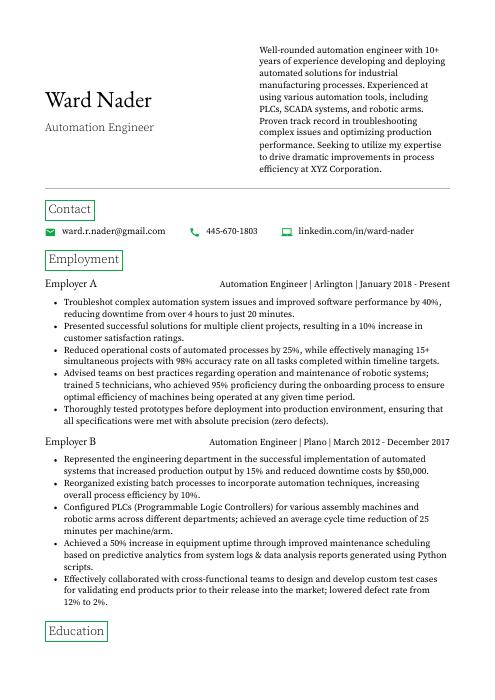 Quokka
Quokka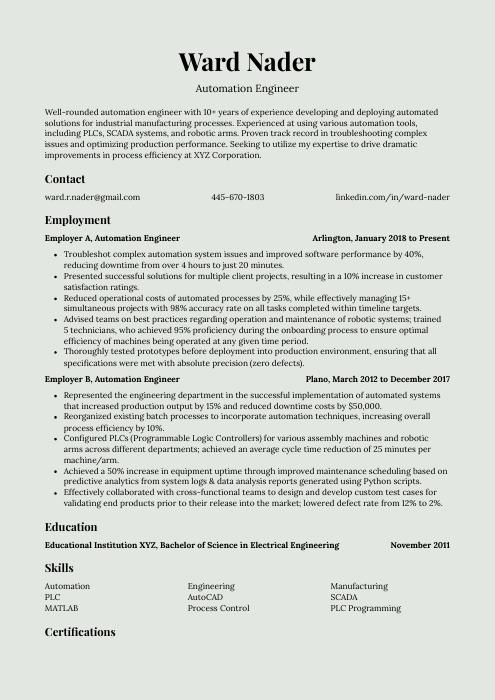 Saola
Saola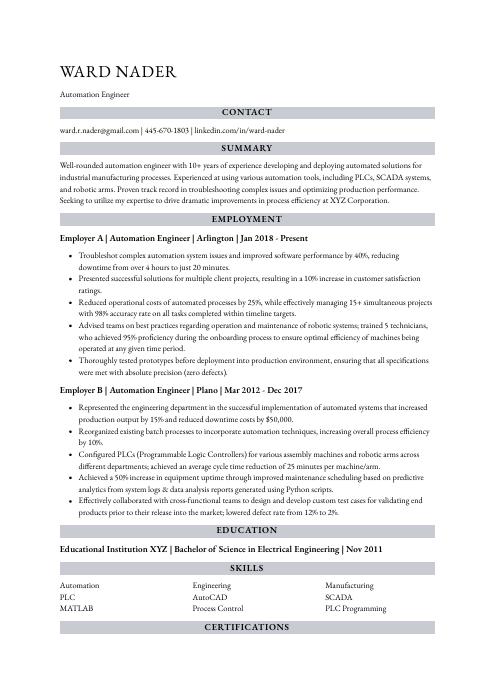 Numbat
Numbat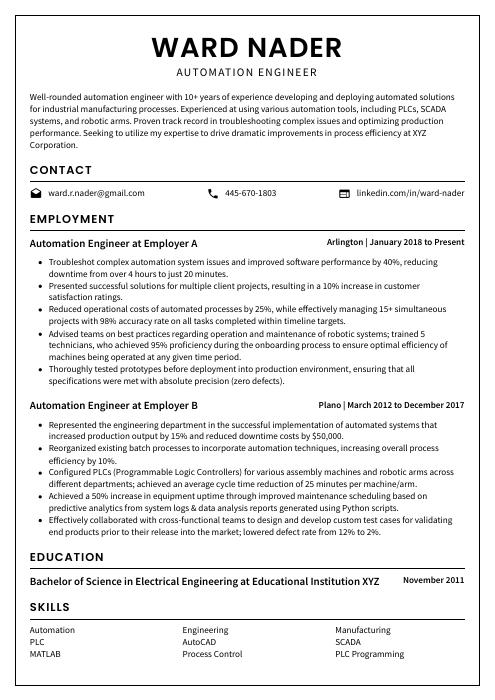 Cormorant
Cormorant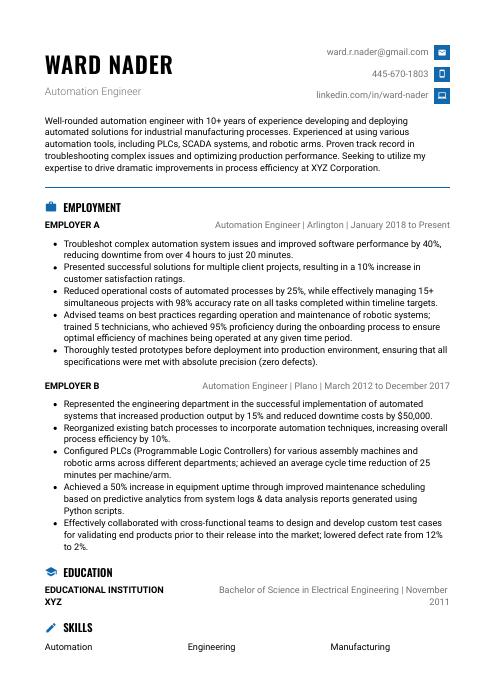 Echidna
Echidna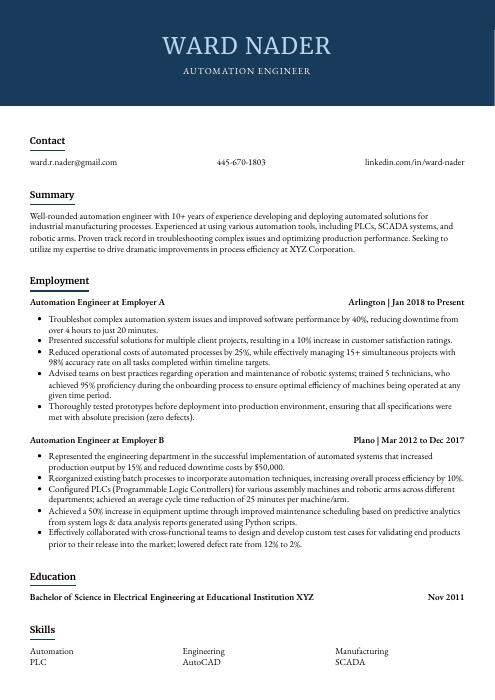 Bonobo
Bonobo Rezjumei
Rezjumei
